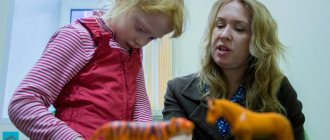Consultation on the development of a child’s speech “Early speech development. Preverbal period"
Usova Tatyana
Consultation on the development of a child’s speech “Early speech development. Preverbal period"
" Early speech development . Preverbal period ."
The first year of a child's life is called the pre-verbal , or pre-verbal , period . It is characterized by morphofunctional maturation of brain structures, including structures associated with the processes of speech , the formation of the vocal tract , and the establishment of coordination between breathing and motor movements, leading to the emergence of articulations.
The sound expressions of a child of the first year of life are called vocalizations. During the preverbal period of development, there is a consistent change in vocalizations: reflex phonations (cries)
- humming - babbling - prewords
(babbling words)
- the first words. At the same time, the emergence of a new type of vocalization does not exclude the child from using previously well-mastered vocalizations.
Stage 1. Reflex phonations (crying)
- from 0 to 1.5-2 months.
The first sound reaction of a newborn is a cry. A cry is an innate reaction to various influences - temperature, pain, tactile, etc. From the moment of birth and in the first 1.5-2 months of life, crying or screaming is the main sound reaction of a baby.
The first cry of a newborn has a certain diagnostic value.
A loud cry at birth is characteristic of a healthy newborn and is accompanied by a deep breath, which well straightens the previously collapsed lungs.
A weak, squeaky cry or its absence may indicate prematurity or birth trauma.
A strangled, weak cry, which does not occur immediately, but some time after birth, is typical for newborns with severe disorders of the nervous system.
A healthy infant, properly dressed, having proper care and feeding, never screams for a long time and for no reason. In the first month of life, babies cry 2 to 4 hours a day.
In the 2nd month of life, the child begins to attract the attention of an adult by crying. Getting an adult's attention in the most accessible way possible, through crying, is essential for the infant's survival. In the animal world, cubs also use the power of their voice to call their mother in case of danger and discomfort.
From the age of 5-7 weeks, the baby's crying changes depending on his condition.
Features of infant crying in various diseases and disturbing influences:
Prolonged constant crying: evidence of discomfort - tight swaddling, wet diapers, etc.
Periodic , paroxysmal crying: intestinal colic and bloating are possible due to incomplete digestion of milk. The pain appears in attacks, between which the child feels well. When you touch the stomach, the pain intensifies and the baby cries more.
Crying when urinating: a sign of cystitis or salt accumulation in the urine.
Crying during bowel movements: a sign of irritation or fissures in the anus.
A monotonous scream, sometimes interrupted by separate, sharper screams: evidence of the phenomena of increasing intracranial pressure during inflammatory processes of the brain and middle ear.
Stage 2. Walking - from 1.5 to 6 months.
Humming (voice-like sounds in various combinations)
is a child’s auditory expression of a positive emotional state.
The time of occurrence is individual. Buzzing is characterized by the child's utterance of sounds that resemble vowels in sound. The sounds are produced by the random position of the infant's tongue in the mouth rather than by clear articulation.
Infants of different nationalities make the same sounds in the first months of life, and only from the second half of life do sounds characteristic of the linguistic environment in which the child is raised appear. The universality of infant sounds is determined by the structure of the vocal apparatus. The vocal tract of an infant is more similar in structure to that of great apes than to the vocal tract of an adult.
In children with hearing loss, humming occurs at the same time as in children with normal hearing.
In children brought up in conditions of social deprivation or suffering from severe diseases of the central nervous system, humming occurs later than in healthy children at home (5-6 months)
.
By the end of the 2nd month of life, the child begins to reproduce sounds pronounced by adults. At three months of age, the child is able to reproduce intonation.
In one of the first domestic studies on this issue
(Koltsova, 1979)
It has been shown that an infant a few weeks old is able to imitate the intonation and sounds of an adult's voice, and the imitation process is more successful if the child sees the speaker's facial expressions.
During the experiment, an adult made articulatory movements for 2-3 minutes in front of two-month-old babies, as if pronouncing sounds, but did not say them out loud. Babies, looking at the adult's face, accurately reproduced his facial expressions. Then the adult said “real”
sounds, and the child actively tried to repeat them.
And then the adult covered his face with a mask so that the child could not see the movement of his lips, but at the same time he uttered sounds out loud, and the child was silent. This example clearly demonstrates that children respond more correctly to a sound signal if it is accompanied by corresponding visual information, that is, the location of the articulatory organs characteristic of a given sound. Consequently, vocal imitation initially develops on the basis of imitation of facial expressions.
The child, imitating the articulatory facial expressions of an adult, involuntarily makes the corresponding sound. One of the most important motor prerequisites for the development of speech is the sucking reflex. Thanks to the training of the lips and tongue during sucking, the development of labial and linguistic sounds occurs intensively.
Stage 3. Babbling - from 5 to 12 months.
At the age of 4-5 months, significant changes occur in the structure of the child’s vocal apparatus: a partition appears between the oral and nasal cavities; The oral cavity increases in volume. This creates the conditions for more varied movements of the tongue and clear coordination between the various structures of the vocal apparatus when pronouncing a sound.
Changes occurring in the structure of the infant's articulatory apparatus provide the ability to pronounce a variety of sounds. The child masters the pronunciation of almost all vowels and some consonants. The inclusion of consonant sounds in vocalizations leads to the formation of syllables, and babbling appears.
Types of babble:
Simple babble (5-7 months)
- sound combinations such as syllables, with a longer pronunciation of a vowel or consonant (
“ba”
,
“da”
,
“ta”
)
Canonical babble (7-11 months)
- repetition of two or three identical syllables
("woman"
,
“pa-pa”
,
“ba-ba-ba”
,
“pa-pa-pa”
)
Syllabic or verbal babble (9 months)
— complication
(in terms of articulation)
of sound combinations.
Complex sound combinations like “vowel-consonant-vowel”
(
“aba”
,
“ogu”
,
“ata”)
, as well as sound combinations starting with a vowel or consonant (
“babab”
,
“tatab”
) and others.
Stage 4. Prewords and first words - from 10 to 12 months.
A babbling word or preword is formed during babbling by combining two identical syllables. By the end of the first year of life, along with babbling words, the first true words appear.
The difference between a babbling word and a true one is that a babbling word has no meaning. For example, a child can use the word “mom”
and mom, and dad, and cat.
A true word differs from a babbling word in that its sound form corresponds to its meaning (Tseytlin, 2000).
Some recommendations for the development of the sound side of speech in the first year of life:
1. From the first days of life, the presence of a loved one, physical and emotional contact with him, is important for a baby. In a healthy, full-term baby, the amount of time during which he cries and the intensity of crying completely depends on the close adult caring for him. Pay attention to your baby's crying patterns. Strive to create the most comfortable conditions for the child - take the baby in your arms, bend over his crib, smile, talk to him, changing intonations, lowering and raising your voice.
2. Follow the feeding schedule. Make sure that the baby correctly grasps the nipple from the bottle and does not tear himself away from it during feeding. Normalization of the feeding process is one of the main conditions for proper early speech development . During sucking, the baby moves his lips and tongue, which he will then use to make sounds. By training the lips and tongue during sucking, labial and lingual articulations develop
3. Encourage your child to make sounds. When communicating with your child, encourage any sound he makes. Smile at him, repeat the sounds after him, take him in your arms. The child should have a desire to communicate with you and “play”
sounds using the tongue and lips.
Sound play is the basis for further development of clarity and ease of pronouncing sounds and words, training for the child’s speech apparatus .
4. It is important for a child not only to hear an adult’s speech addressed to him, but also to see his face, to be able to follow the movements of his lips and changing facial expressions. If you and the child fix their gaze only on each other during the interaction, then such interaction is called symmetrical. With this form of interaction, you can try to change facial expressions, pronounce sounds, articulating them clearly. The child will imitate you. Since the time during which the child can focus his eyes on your face is very short - from 30 seconds to 2 minutes - try to use it to the benefit of the child.
Symmetrical interaction is the best form of attracting a child's attention. It is with this form of mutual attention that the baby learns to pronounce sounds after you. Strive to structure your behavior in such a way that the child is interested in communicating with you. After six months of age, infants show a preference for their surroundings over the adult's face.
5. Diversify your child’s sound environment. Talk to your child, changing the intonation and pitch of your voice. Along with your voice, your baby can benefit from listening to other sounds. For a short time (a few minutes)
turn on the radio, but it’s better not loudly, but so that its sound is muffled.
6. A constant noise environment negatively affects a child’s early speech development . If a baby spends a long time in a room with a high noise level, with loud music, constant conversations from adults, or the TV and radio on, his speech development slows down . The baby stops making sounds, his vocal reactions develop slowly and are characterized by a poverty of sounds, sound combinations and intonations.
7. Train your child’s fingers, give him a hand massage, use finger games.
8. Develop your child's understanding of speech . Show interest in those toys that the child fixes his gaze on, and also introduce new objects into interaction with the child (this is especially important from the second half of his life, comment on your actions. When showing the child an object and naming it, try to demonstrate the properties of this object - so baby will remember it better. Try to repeat such “lessons”
several times a day.
The more often you talk to your child about subjects that are familiar to him, the faster he will develop understanding of speech .
Accompany with verbal comments everything that your baby encounters in the process of actively learning about the world around him. By repeating certain words and demonstrating what they mean, the child will gradually learn their meaning. Even before he can pronounce the word himself, he will already know its meaning. A child’s ability to look for an object that an adult is asking him about indicates that he has begun to understand the meaning of the word.
9. Encourage your child to name the object after you.
10. Teach your child to follow simple instructions. Gradually make the tasks more difficult. When communicating with your child, introduce new requirements for him, clearly express your requests, wishes, instructions using specific words, that is, set speech tasks .
11. While working with your child, develop both understanding of speech and pronunciation of words. Your child’s ability to voice his desires or needs depends on your efforts. If you show persistence, encouraging your child to actively use speech , do not indulge his desires, and demonstrate by your own example the desired way of communication, you will achieve positive results. After some time, the child will learn to express his desires and needs through speech .
12. An important condition for teaching a child the correct pronunciation of sounds and words is the correct speech of adults . When communicating with your baby, take into account his speech capabilities . The requirements for a child's speech must correspond to his age. When teaching a child, you should not overload him with difficult to pronounce and obscure words.
Try to become good teachers and helpers for children on the difficult and long path of language acquisition.
What should mom do?
By “infecting” the baby with positive emotions, the mother stimulates his interest in the outside world, and since the satisfaction of this interest involves the expenditure of physiological resources, she stimulates in a certain direction both metabolic processes and tissue differentiation in the body of her baby. On the contrary, by transmitting negative emotions to the baby, we suppress not only his interest in the outside world, but also certain biological processes of his body. It is no better when the adults around the child “infect” him with too strong affective emotions.
These energy-intensive emotions deplete the child’s nervous system and can lead to somatic diseases. An adult’s mechanical fulfillment of routine tasks, his indifferent, indifferent attitude towards a small child excludes the possibility of any kind of emotional contact at all. With such an adult, the child does not have the need to communicate, and therefore does not develop cognitive experience and does not form the necessary communicative-cognitive means. There is a threat of delayed mental development and disruption of the child’s further interaction with adults. The child’s brain develops incorrectly or is delayed in the absence or deficiency of external stimuli.
And, vice versa: interest in an adult, curiosity about the outside world and communicative-cognitive activity are caused and supported, as we have seen, by positive emotions emanating from an adult. Therefore, we can repeat once again that for infancy, the emotional communication of a child with an adult is not a luxury, but a primary necessity, a condition for the formation of his psyche according to the human social type. Depriving an infant of the emotional attention of an adult at this early age leads primarily to abnormal development of the child’s personality.
If parents notice trouble, and this is not one symptom, but several (lack of babbling, humming, change in voice, behavior), then you should contact a specialist. And then, along with speech therapy correction (massage, articulation gymnastics, stimulation of vocal reactions), drug treatment, physiotherapy, etc. are prescribed.
Sound pronunciation
- The pronunciation side of a child’s speech can be judged only when he has accumulated a significant vocabulary. The time and order in which sounds appear varies from child to child. In the third year of life, a child has the right to incorrect sound pronunciation. Thus, he usually skips or replaces whistling sounds (S, Z, Z', Ts), hissing (Sh, Zh, Ch, Shch) and sonorant sounds (R, R', L) (S-S'; Z-S' , V; C-T'; Sh-S', T'; Zh-S', D'; Ch-T'; Shch-T'; R-L'; R'-L'; L-L')
- If any violations of the pronunciation aspect of speech are detected in infants, timely corrective measures and additional examinations by other specialists are required. The prospects for mental development, the success of education of children with disabilities in neuropsychic development, their school and social adaptation depend on the early detection of disorders in cognitive activity. But often speech therapists at the clinic advise you to wait a little - “don’t come before 5 years.” This can be explained by the fact that working with a child requires a special individual approach, and not every specialist has the necessary knowledge, experience, and most importantly, the desire to work with young children. But a good speech therapist will not brush off worried parents.
- If a child aged 1.5-3 years does not have active speech, it is necessary to arrange an appointment for a consultation with competent specialists: a neurologist, psychologist, speech therapist, otorhinolaryngologist, and conduct a series of diagnostic studies. Parents should be concerned about speech delays not only when the child has no speech at two years old, but also in cases where development is delayed or there is a complete absence of humming and babbling. Observations by specialists and objective data from medical research will make it possible to clarify the nature of the disorder, the degree of its complexity, suggest possible causes and organize adequate assistance for the child.
- At any age, speech impairments limit cognitive activity and the possibilities of social adaptation of a person. Consultations with competent specialists and correctional classes with speech pathologists and speech pathologists will help distinguish speech disorders from other disorders (mental retardation, mental retardation, hearing impairment, autism spectrum disorders) and make a more accurate diagnosis. Early correction and systematic speech therapy sessions, which are essentially a well-organized game, can completely compensate for a speech defect.
- The importance of speech development at an early age is great: speech, along with intelligence, is an important indicator of a child’s development, and its violations are evidence of trouble in the mental sphere. Speech reflects the success (or failure) of mastering the native language - the main social acquisition of the child during this period.
- The speech of a young child reflects the development and lays the foundations for future higher mental functions: memory, attention, thinking, and therefore all further education of the child, and ultimately his social adaptation and success. That is why in correctional and developmental work with young children, special attention is paid to the stimulation (formation) of speech activity.
About organizing classes
The development of a child’s speech occurs at every moment of his life. Everyday situations, including getting ready for bed, washing, eating, take place under almost the same conditions. This helps enrich children's vocabulary and strengthen their speech skills. Contacting children for various reasons creates their need for communication. At the same time, it is necessary to more actively use play and everyday situations that are pleasant for the child. For example, when washing or bathing a child, you can hum a composed song as you go, drawing the baby’s attention to the parts of the body and face about which it is sung, with a gentle touch:
- Where, where, where, where, where are our hands? (2 times)
- Here they are, here they are, here are our hands. (2 times)
- Where, where, where, where, where are our legs? (2 times)
- Here they are, here they are, here are our legs. (2 times)
- Where, where, where, where, where is our tummy? (2 times)
- Here it is, here it is, here is our tummy. (2 times)
- Where, where, where, where, where are our eyes? (2 times)
- Here they are, here they are, here are our eyes. (2 times)
- Where, where, where, where, where are our cheeks? (2 times)
- Here they are, here they are, here are our cheeks. (2 times)
The mother's affectionate voice and pleasant stroking movements will stimulate the child's independent vocal reactions.
Just communicating with your baby in everyday life is not enough for his development. It is necessary to use speech in objective and play activities. It is also advisable to conduct specially organized classes (games and activities). It is important to consider that at an early age, all tasks given to the child should be offered as an entertaining and interesting game. Only against a positive emotional background will the baby himself want to say a new word, repeat a combination of sounds or a phrase he heard.
When learning new words, you should always use a toy or object first and then a picture. If the child easily recognizes and names familiar objects and toys, you should gradually move on to working with subject and plot pictures.
Speech therapist, neurodefectologist Elena Gennadievna Timoschenko, author of the Territory of Health series of lectures “Early development of speech and intelligence of a child.”








